By Belén Carrasco Rodríguez and Benjamin den Braber
Executive summary
From active measures to false flag operations, the Kremlin has a well-established track record of fabricating intelligence to achieve its geopolitical goals. This has continued, if not increased, during Russia’s unprovoked invasion of Ukraine.
On 30 June, Russia retreated from Snake Island, a critical Black Sea outpost and one of the main symbols of Ukrainian defiance. Russia issued a litany of claims around its retreat. This investigation by the Centre for Information Resilience’s Eyes on Russia (EoR) project provides evidence that debunks the claims used by the Russian Ministry of Defence (MOD) to justify the withdrawal:
Claim 1: The withdrawal was an act of goodwill;
Claim 2: Russian forces fulfilled their objectives on the island and were ready to leave;
Claim 3: Russia doesn’t want to interfere with the United Nations’ mission of organising humanitarian corridors to export grain from Ukraine.
We uncover how Russia has manipulated the information environment in order to avoid the humiliation of losing Snake Island, a territory of geostrategic and symbolic importance, and to place blame on Ukraine and the West for the global food crisis.
Chronological analysis of Ukraine’s targeting of Russian military positions on the island and their resupply routes indicates that Ukraine’s steady pressure was the likely main trigger of their withdrawal.
After the start of the withdrawal by Russian forces, several official sources [Ukrainian and Russian] stated that Russia continued targeting the island. This supports the idea that Russia had not given up militarily, contradicting claims made by the Russian MOD. Although Russia claims it does not want to disrupt the export of grain from Ukraine, visual evidence analysed during this investigation suggests otherwise.
Introduction
Snake Island, also known as Serpent Island or Zmiinyi Island (острів Змії́ний), is an island within Ukraine’s Odessa Oblast, in the South West of the country. It is located in the Black Sea, 35 kilometres from the coast of Ukraine and 45 kilometres from Romania. The speck of land has an important role in delimiting Ukrainian territorial waters.
On 24 February, the first day of the Russian invasion of Ukraine, two Russian naval warships attacked Snake Island, ultimately leading to Russian forces taking control of the island. It remained occupied for 126 days.
Russia announces its withdrawal from Snake Island
On the morning of 30 June, the People’s Deputy of Ukraine (Member of Parliament), Олексій Гончаренко (Oleksiy Honcharenko), announced Russia’s withdrawal from Snake Island on his Telegram channel.

Figure 1: Honcharenko’s Telegram post announcing Russia’s withdrawal from Snake Island on 30 June 2022 at 08:19 AM (GMT) [Translation: “The orcs have left Snake Island (I’m checking the information)”].
Игорь Конашенков (Igor Konashenkov), the spokesperson for the MOD of the Russian Federation, confirmed this a few hours later with an official statement released on their website.
In the statement, the military officer not only stated that they had pulled out of their own free will but also claimed it was a gesture of goodwill to enable humanitarian corridors for grain export. This message was quickly amplified by Kremlin-affiliated and pro-Kremlin media in another attempt to boost support among Russian-speaking audiences and back the Kremlin’s actions in the war. However, our investigation provides evidence that the following claims from the Russian MOD were highly unlikely:
Claim 1: The withdrawal was an act of goodwill;
Claim 2: Russian forces fulfilled their objectives on the island and were ready to leave;
Claim 3: Russia doesn’t want to interfere with the UN’s mission of organising humanitarian corridors to export grain from Ukraine.
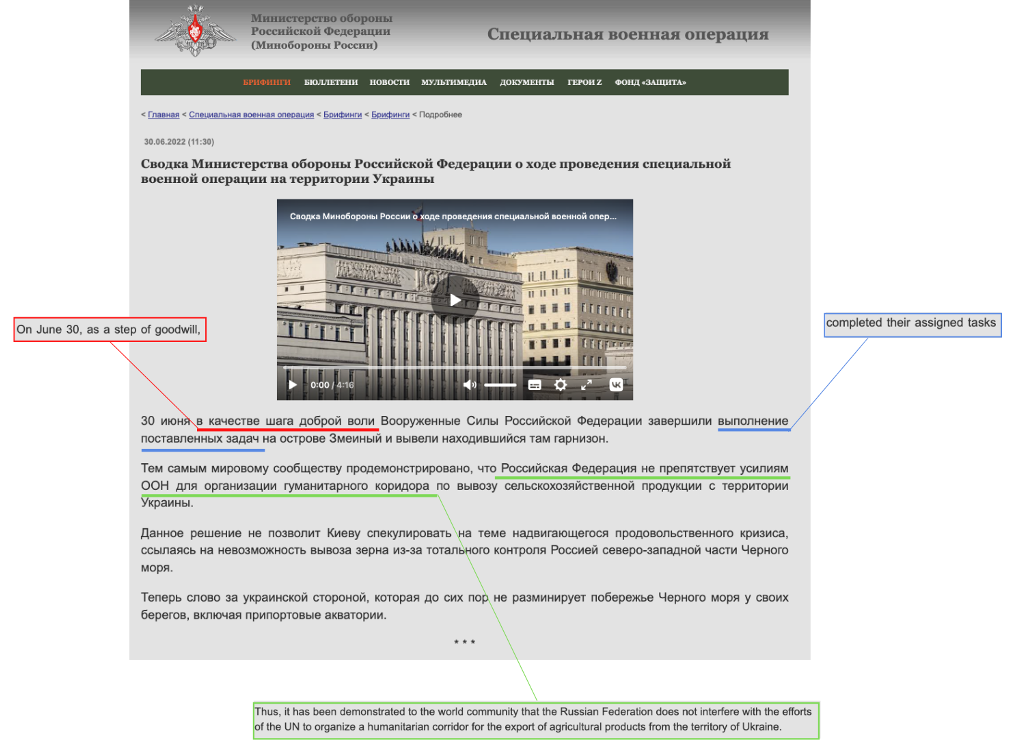
Figure 2: Report by the Ministry of Defence of the Russian Federation on the progress of the special military operation on the territory of Ukraine published on 30 June 2022 (11:30 GMT+3).
By using the UK’s RESIST framework to debunk these three claims, this report uncovers how Russia has manipulated the information environment in order to avoid the humiliation of losing Snake Island, a territory of great geostrategic and symbolic relevance, and to place blame on Ukraine and the West for the global food crisis.
Debunking Claim 1: Why Russia’s retreat was not an act of goodwill
The Russian description of the events that took place on 30 June was rapidly challenged by Western governments, academia, and digital investigators. Indeed, open-source evidence indicates this was not a “goodwill withdrawal”:
Firstly, satellite imagery shows significant destruction caused by heavy shelling of Snake Island by Ukrainian forces on the day of the withdrawal.
Secondly, chronological analysis of Ukraine’s targeting of Russian military positions on the island and their resupply routes indicates Ukraine’s steady pressure was the likely main trigger of their withdrawal.
Ukraine’s military efforts to retake the island were not mentioned in the statement released by the Russian MOD. However, the destruction of Snake Island, captured by satellite imagery between the 29 and 30 June, as Russian forces were pulling out, matches claims that Ukrainian forces targeted Russian positions on the disputed territory.
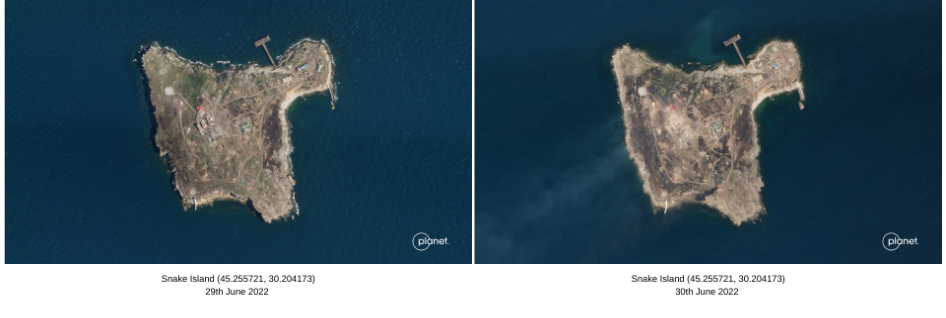
Figure 3: Satellite imagery obtained between 29 June [left] and 30 June [right] shows the destruction of Snake Island during Russia’s withdrawal. Courtesy of @Planet.
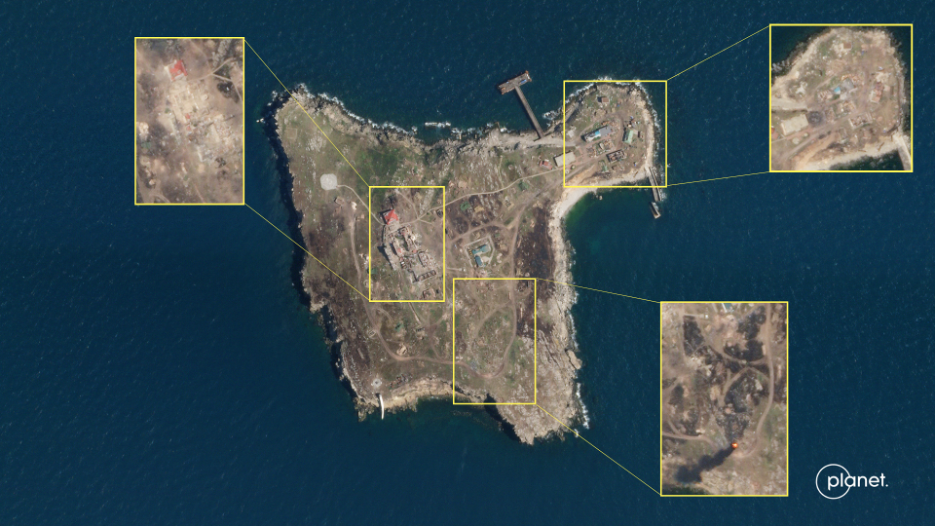
Figure 4: Key areas targeted around 30 June, the date at which Russian forces started withdrawing from the Island. Courtesy of @Planet.
Ukraine had consistently targeted Russian forces on and around Snake Island between April and July, which reinforces the standpoint that the withdrawal was caused by Ukraine’s steady pressure on Russian positions:
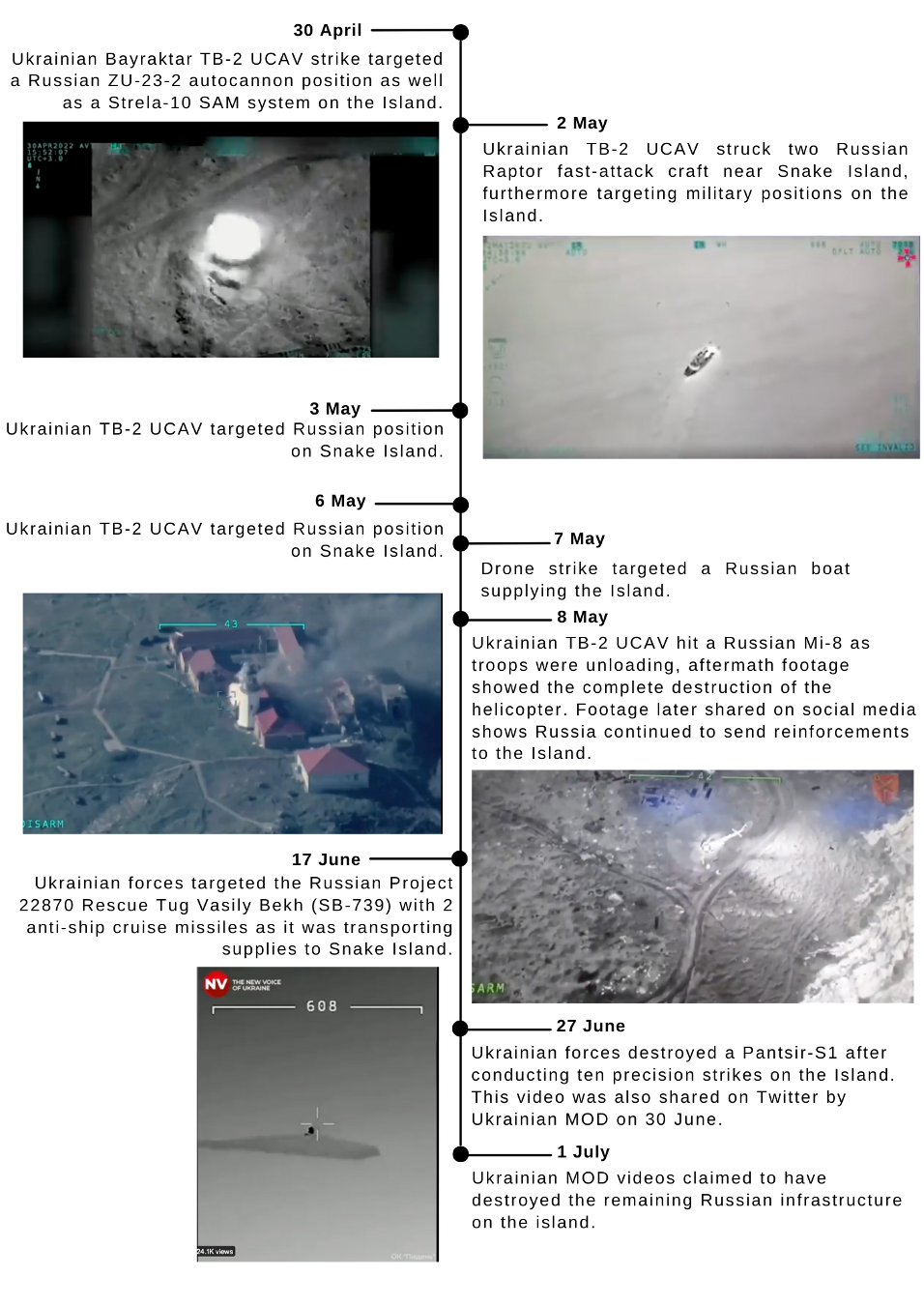
Figure 5: Timeline showing Ukraine’s military efforts to retake the island on 30 April, 2 May, 3 May, 6 May, 7 May, 8 May, 17 June, 27 June, and 1 July.
User-generated content found on social media verifies that Russian forces had a self-propelled, anti-aircraft ‘Pantsir-S1’ stationed on the rocky islet, which was ineffective in defending the island.
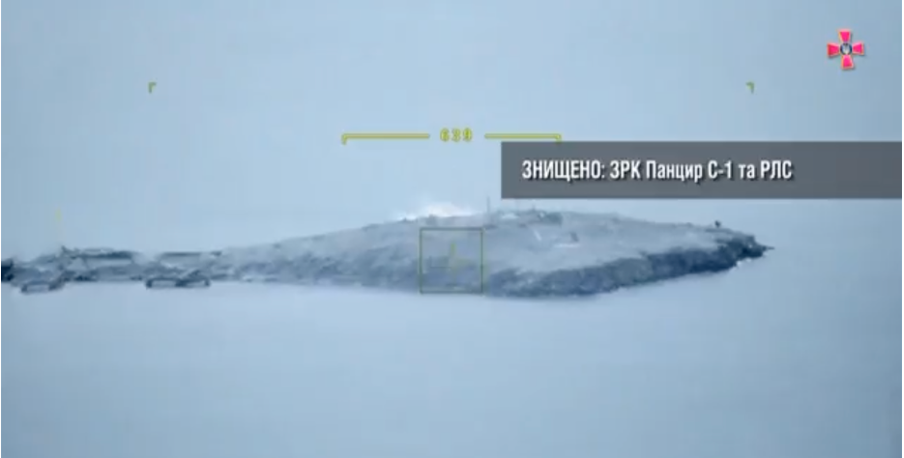
Figure 6: Screenshot of drone footage showing Ukrainian forces destroying a Pantsir-S1 air defence system on 30 June.
Chronological analysis of Ukraine’s targeting of Russian military positions on the island and their resupply routes indicates that Ukraine’s steady pressure was the likely main trigger of their withdrawal.
Debunking Claim 2: Russia’s actions before and after the withdrawal indicate they had not fulfilled their objectives by 30 June.
Three arguments support the notion that Russia had not fulfilled its objectives on the island at the time of the retreat:
Firstly, statements by Russia’s MOD during the week prior to 30 June.
Secondly, actions by Russian forces after 30 June.
Thirdly, the recognised geostrategic and symbolic importance of the island for both Ukraine and Russia.
1. Statements prior to 30 June
Analysis of declarations made by official Russian government sources confirms that Russia was by no means planning on surrendering the island. For example, on 23 June, a week prior to leaving the island, the Ministry of Defence voiced its intentions to keep the island under Russian control:
“On 20 June, at about 5 o’clock in the morning, the Kyiv regime made another crazy attempt to take possession of Zmiinyi Island. It would seem that the loss of elite fighters during the previous attempt should have made it clear to the Ukrainian military leaders that this island will remain under our control. However, that disastrous landing on Zmiinyi taught them nothing.”
This was reiterated during a morning briefing on 26 June when Konashenkov indicated Russia was actively defending the island while speaking about another allegedly “unsuccessful landing attempt” by Ukrainian forces.
2. Actions after the 30 June
After the start of the withdrawal from the island by Russian forces, several official sources [Ukrainian and Russian] stated that Russia continued targeting the island, in order to deter Ukrainian forces from using the island after Russia’s withdrawal. This supports the idea that Russia had not given up and contradicts the statement made by Konashenkov, which claimed that Russia had “completed their assigned tasks on Zmeiny Island”. The following actions lend further support to this view:
1 July: According to the commander-in-chief of the Ukrainian army, Валерій Залужний (Valeriy Zaluzhnyi), two Russian Su-30 fighter jets allegedly dropped phosphorus bombs on the island. This claim was accompanied by footage showing a jet dropping several bombs on and around Snake Island.
7 July: Russian Defence Ministry spokesman Igor Konashenkov, in a daily news briefing, claimed Russian forces had targeted the island again, stating: “At about 5 a.m., several Ukrainian servicemen landed on the island from a motor boat and took pictures with the flag. An aircraft of the Russian Aerospace Forces immediately launched a strike with high-precision missiles on Snake Island, as a result of which part of the Ukrainian military personnel was destroyed.”
13 July: The British Ministry of Defence and Ukrainian sources said that Russian fighter jets were still trying to hit the island.
3. The geostrategic and symbolic value of Snake Island
Domination of the Black Sea region is a geostrategic imperative for Moscow. Snake Island plays a significant role in controlling the Northwestern Black Sea, Ukrainian coastal cities and shipping routes that form an important part of the global grain supply chain. Additionally, it is around 45 kilometres off the coast of Romania, which is a NATO member.
The retreat was not only a military victory but also a morale booster for Ukrainian forces. The island was the stage for one of the most famous symbolic events during the invasion so far. On 24 February, when the Russian flagship cruiser Moskva began the assault, a small detachment of thirteen Ukrainian border guards was told to surrender. However, instead of surrendering, the soldiers radioed back, “Russian ship, go fuck yourself!”. This event, which resulted in the death of all thirteen Ukrainians, transformed Snake Island into one of the earliest symbols of Ukrainian defiance during the invasion.
With the recovery of the island, another symbol emerged: a Ukrainian cat that allegedly survived the Russian occupation and constant bombings.

Figure 7: Products branded with both events occurred in Snake Island, selling on Amazon.
Prior to leaving the island, the Russian Ministry of Defence voiced its intentions to keep the island under Russian control, after the start of the withdrawal, Russia continued targeting the island. This supports the idea that Russia had not given up on the Island and contradicts claims made by the Russian MOD.
Debunking Claim 3 – Although Russia claims it does not want to disrupt the export of grain from Ukraine, visual evidence suggests otherwise
Snake Island has not been the first or only instance where Russia has been accused of disrupting grain exports.
Russian airstrikes on Ukrainian farms have set grain fields on fire. Russian airstrikes on Ukrainian farms have set grain fields on fire. This has been widely reported on by the international community, and analysts have claimed the consequences were deliberate. EoR investigators have verified a significant amount of damage to agricultural facilities and land.
6 June: Russia launched a missile strike on the Nika-Tera private port and a grain terminal in Mykolaiv, Ukraine. This led to the complete destruction of two hangars, and damage of two more. This activity, according to Josep Borrell, the European Union’s Foreign Affairs High Representative, is “contributing to the global food crisis.”
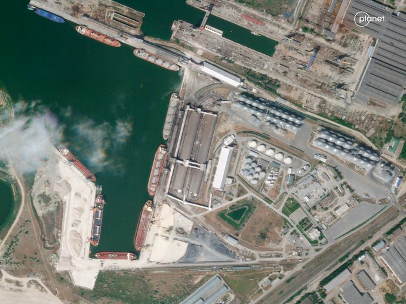
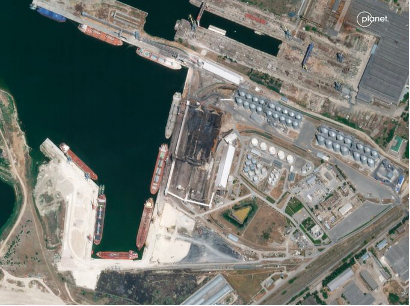
Figure 8: Satellite imagery shows the grain terminal before [left] and after [right] it was struck by a Russian missile. Courtesy of @Planet.
11 June: TASS, a major Russian state-owned news agency, released footage showing Russian forces transporting grain from areas inside Ukraine. The footage, geolocated by EoR investigators, was filmed in Starobilsk, Luhansk Oblast, a city that was occupied after the start of the Russian invasion. This indicates that the grain was produced by Ukrainian farmers and taken by Russian forces after they had taken control of the Area.
24 July: A day after Ukraine and Russia struck a deal regarding the export of grain, the Black Sea port of Odessa, crucial for grain exports, was struck by a Russian missile strike. This put the deal made the day prior in danger of collapsing.
Conclusion
Although Russia claimed the retreat from Snake Island was a “gesture of goodwill”, statements made by Russian officials prior to the retreat, as well as continued Russian targeting of the Island after its retreat, suggest the Russian forces were forced to abandon the Island.
The retreat by Russian forces was likely due to the continued targeting of the Island by Ukrainian forces, as backed up by open source evidence, leading to a symbolic as well as a military win for Ukraine Furthermore, although Russia claims it does not want to disrupt the export of grain from Ukraine, visual evidence indicates targeted strikes on grain facilities, jeopardising the deal with Ukraine regarding the export of grain.
The Kremlin’s disinformation playbook aims to distort audiences’ perceptions about the war. Using continuous manipulation of evidence and denial of facts, Russia tries to deflect responsibility for the consequences of the war, such as the global food crisis, and avoid the humiliation of losing key territories such as Snake Island.
As Russia loses positions due to the counteroffensive in the northeast of Ukraine, this trend is expected to increase, which makes monitoring of claims by Russian officials and OSINT investigations vital tools in exposing the truth around the invasion of Ukraine.
